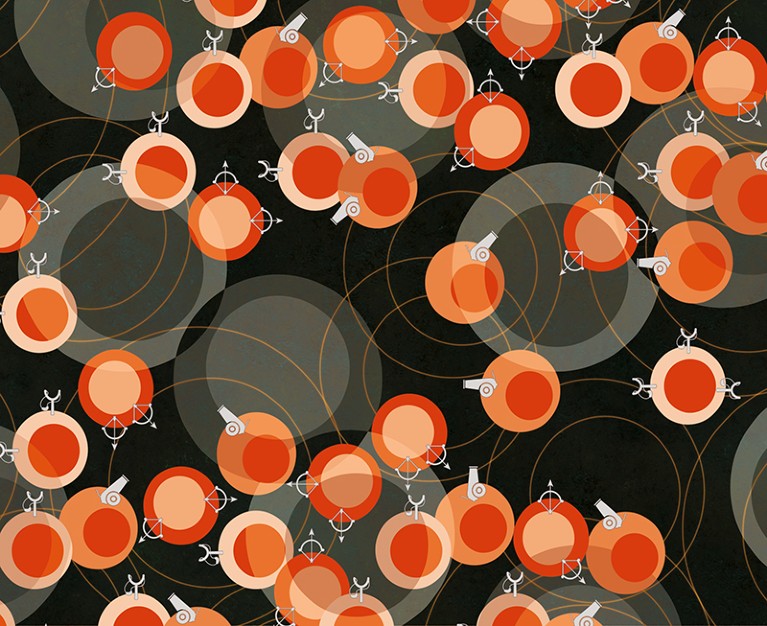
Credit: S. Fenwick / Springer Nature Limited
T cells, which can efficiently identify and kill infected cells, can also kill cancer cells if they recognize them. Adoptive cell therapies (ACT) leverage this cytotoxic capacity of T cells to eradicate tumours.
The first successful clinical applications of ACT for cancer treatment occurred in the 1980s. In these pioneering studies by Steven Rosenberg, tumour-infiltrating lymphocytes (TILs) were isolated from patients with melanoma, then activated and expanded before reinfusion into the patients. In the first published gene therapy clinical trial, TILs engineered to express a foreign gene with a retrovirus to mark the infused cells were safely transferred to patients. This study also showed that modified T cells could persist for months after transfer—a key requisite for future ACT. However, although treatment with TILs was effective in some tumours (such as melanoma), the lack of specificity and the difficulty in recruiting TILs from most other cancer types compromised the therapeutic potential.
In 1989, Zelig Eshhar and colleagues realized that the inability of T cells to recognize surface tumour antigens could be overcome by replacing domains of the T cell receptor (TCR) with antibody parts with specificity towards proteins on these cells. They combined the variable region of an antibody with the constant regions of the TCR chains, thus producing chimeric antigen receptors (CARs) that provided T cells with antibody-type specificity. The T cells expressing CARs recognized and eliminated target cells, and produced interleukin 2 in the presence of the antigen, providing a proof of concept that this approach triggers a cellular immune response.
Physiologic recognition of tumour antigens by T cells is mediated by the TCR–CD3 complex. However, this complex alone is insufficient to trigger productive T cell responses, which require the concomitant engagement of co-stimulatory receptors. In 2002, Michel Sadelain and colleagues optimized CAR design by integrating the intracellular domains of TCR and the key co-stimulatory receptor CD28 within a single molecule to help sustain T cell expansion, function and persistence. Other similar second-generation CARs subsequently emerged, incorporating different co-stimulatory domains, such as 4-1BB, which Crystal Mackall and colleagues showed can decrease the T cell exhaustion induced by continuous CAR signalling, thereby improving antitumour efficacy.
In 2010, James Kochenderfer and colleagues achieved a breakthrough with a CAR T cell therapy, reporting tumour regression in a patient with advanced follicular lymphoma, who received two infusions of autologous T cells genetically engineered to express a CAR specifically recognizing the antigen CD19 expressed on B cells. The finding that CAR T cells had activity in patients advanced the field of ACT, which saw dramatic progress in the following years and remarkable results in B-cell malignancies, including paediatric and adult acute lymphoblastic leukaemia (ALL), aggressive B cell lymphomas, chronic lymphocytic leukaemia and multiple myeloma treated with CD19 CAR T cells. In 2017, two studies—the phase II ZUMA-1 trial led by Sattva Neelapu and a case-series study led by Carl June—validated the efficacy of CD19 CAR T cells in patients with refractory B-cell leukaemia and lymphoma. Later that year, CD19 CAR T cells received US FDA approval for the treatment of children with ALL and adults with aggressive lymphomas.
Another ACT developed in parallel to CAR T cells is engineering T cells to express TCRs that recognize tumour-associated antigens. This approach offers the advantage of targeting antigens not present on the cell surface. In 2006, Rosenberg and colleagues transferred TCR T cells specifically recognizing the melanoma antigen MART-1 in 15 patients, two of whom achieved regression and still showed high levels of engineered cells in circulation one year after the infusion. This was the first clinical use of TCR T cell therapy, and although initial studies had demonstrated the feasibility and safety of introducing engineered T cells in patients, this trial also showed their remarkable efficiency. Other successful studies quickly followed, such as those demonstrating sustained complete and partial responses in patients with melanoma and treatment of synovial cell sarcoma with TCR T cells against the NY-ESO-1 antigen.
Despite the success of T cell immunotherapies, important roadblocks remain. Disease relapse and acquired resistance to CD19 CAR T cell therapy due to antigen loss can occur after initial responses. Toxic effects—such as cytokine-release syndrome or immune effector cell-associated neurotoxicity syndrome—are also an important hurdle, and biomarkers of response and toxicity are urgently needed. Novel CAR constructs are being developed to address these limitations, including multiple-antigen-targeting CARs, inclusion of cytokines to improve efficacy and conditional expression of CARs to regulate CAR activity and safety. Advances in cell engineering are enabling the use of CARs with other immune cells such as natural killer cells, and gene-editing techniques such as CRISPR-Cas9 could address limitations related to the complexity of CAR designs and the cost of manufacturing. Collectively, these new approaches could extend these revolutionary ‘living drugs’ to many more patients in the future.

 Nature Milestones in Cancer: Interactive Timeline
Nature Milestones in Cancer: Interactive Timeline
 Human T-lymphocyte cytotoxicity and proliferation directed by a single chimeric TCRζ/CD28 receptor. (Maher, J. et al., 2002)
Human T-lymphocyte cytotoxicity and proliferation directed by a single chimeric TCRζ/CD28 receptor. (Maher, J. et al., 2002)